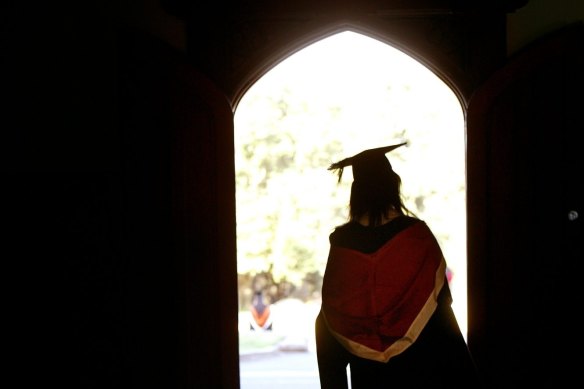With inflation raging, it’s time we rethink student debt
Save articles for later
Add articles to your saved list and come back to them any time.
As someone who still has a very substantial HECS-HELP debt from my years of study, I often fantasise about the government getting in contact with me and offering to wipe the debt completely – or at least shave a bit off the top.
While we all know that’s not going to happen, last week – for 13,748 individuals from 104 higher education institutions – it did, the lucky ducks. Due to missing information provided to the Department of Education, including crucial details such as student tax file numbers and errors related to upfront loan discounts, students found themselves in this enviable position.
Our current student loan system is getting in the way of creating a more educated Australia. It’s time we revised it.Credit: Louise Kennerley
They couldn’t view their real-time debts, including indexation amounts and repayments, on the Australian Taxation Office (ATO) website via myGov – and in a rather generous move, the Australian government decided to waive the annual indexation for these impacted students for both previous years and 2023.
That equates to a whopping $5.4 million shaved off collective student debt. With this year’s indexation spiking to 7.1 per cent and the average national student debt sitting at a concerning $24,770.75, this waiver equates to potential savings of around $1,759 for those students – a money win in my eyes!
While the reprieve might sound like a windfall, it also shines a light on a broader issue. The current financial year has seen some students and graduates with HECS debts receiving a break from making compulsory repayments, thanks to changes in the compulsory repayment thresholds.
Last year, the threshold sat at $48,361, which meant that anyone with a student loan earning above this amount had to start repaying. This year, that threshold has been adjusted to $51,549, granting a brief respite for some. Although these changes are annual, the consistent upward trend signifies the rising costs and challenges that come with modern Australian life.
Our current student loan system is getting in the way of creating a more educated Australia.
The increasing financial strain is apparent when you examine the inflation-linked indexation rate, a sizable 7.1 per cent this year which I have discussed on a number of occasions since starting this column.
This spike added an extra $1758.72 to the average national student debt, catching many students off-guard and sending them into a spin. Moreover, the repayment rates, depending on your earnings, can range from nil to a significant 10 per cent for those who earn more than $151,201.
From my perspective it’s essential to note a crucial aspect here: deferring the payment might seem like an immediate relief, but it can mean paying more in the long run due to the indexation applied to the loan.
This year’s 7.1 per cent indexation is a stark reminder of the potential pitfalls of waiting to settle your student loan. When this indexation rate was announced, my inbox was overflowing with queries from my community about what they need to do to stay out of a financial pickle.
Historically, university education was free in Australia until the end of 1988. But with the introduction of the HECS on 1 January 1989, the landscape shifted. Over time, as the cost of living has soared, coupled with the pressures of university debts, young Australians aiming to create a pathway for themselves and build their careers are finding it increasingly challenging.
Adding to their woes is the alarming revelation from the ATO that 15 per cent of Australians, (equating to over three million people), struggle with their student debt. A recent survey indicated that over half of these debt-ridden individuals are anxious about their repayment capability – which is something that makes me anxious, given the cost of living crisis we are currently experiencing.
Worse yet, 14 per cent believe they will never be able to clear their student loans. These escalating worries not only rain on young Australians’ aspirations – like owning property – but cast a looming shadow over their financial futures.
Policymakers are also fairly feeling the heat. Eight crossbench MPs and senators have petitioned Prime Minister Anthony Albanese and Education Minister Jason Clare recently, emphasising the alarming pace at which student debts are inflating, outstripping the speed of repayments.
Such escalating debt especially impacts young people and women, amplifying societal inequalities – something I could rave on and on about – but I’ll save that for another day.
In the heart of this financial turbulence, the unexpected waiver due to an admin error might appear as a beacon of hope for the affected students, however, it really does accentuate the urgent need for broader solutions.
Our current student loan system is getting in the way of creating a more educated Australia (in a way that I’m assuming they didn’t expect when they introduced the scheme in 1989) and it needs to be revised sooner rather than later.
Victoria Devine is an award-winning retired financial adviser, best-selling author, and host of Australia’s number one finance podcast, She’s on the Money. Victoria is also the founder and co-director of Zella Money.
- Advice given in this article is general in nature and is not intended to influence readers’ decisions about investing or financial products. They should always seek their own professional advice that takes into account their own personal circumstances before making any financial decisions.
For expert tips on how to save, invest and make the most of your money, delivered to your inbox every Sunday, sign up for our Real Money newsletter here.
Most Viewed in Money
From our partners
Source: Read Full Article
